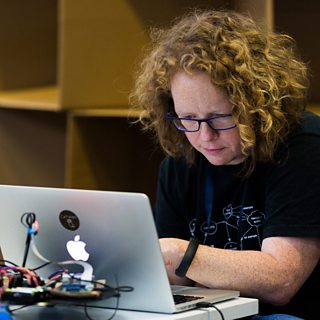The R&D Futures project develops our ability to pick up on trends in audience habits and their media and technology landscapes. We try to extrapolate how these trends might play out over the next few years and how R&D and the ΒιΆΉΤΌΕΔ might respond.
One of the ways we do this is by gathering links to things that we think look like signals of change and periodically bundling them together for analysis. This is our bundle for November 2021!
The project is run by Libby and Henry and a rotating crew of colleagues from across R&D and the wider ΒιΆΉΤΌΕΔ. If you're interested in collaborating with us, get in touch!

Are we seeing a cultural shift towards subtitle use? |
VC money, DAOs and toxicity
Extensive money and attention is being poured into various crypto currency projects involving the use of blockchain and βsmart contractsβ to make distributed autonomous organisations (DAOs). These are communities where typically the decision making is is proportionate to the holding of some crypto coin, and are often created for the purpose of doing something specific, for example (though this ). But sometimes they are more flexible, deciding to do something together, like an investment vehicle. The smart contract / blockchain layer is a level of unneeded (and centralised) infrastructure atop a typically oligarchical decision-making structure and . Twitter recently announced a crypto team focusing on blockchains, and other decentralized technologies. And perhaps also . Meanwhile, itβs all getting .
β Libby Miller
Youthquake
I attended the Radio Festival where Matt Deegan talked about youth audiences, they key finding being that young people consume the amount of radio that they do at 15 throughout their life.
This is a concern because radio has dropped by 40% in listnening hours for 15-19 yr olds. This is an opportunity for us to think about how to make programming for younger audiences and to involve them in the decision making around content creation.
β Prabhjit Bains
Young viewers prefer subtitles
Research by Stagetext's βYoung people are almost four times more likely than older viewers to watch TV shows with subtitlesβ, despite having fewer hearing problems.
Is there a βcultural shiftβ going on? brain rewiring?
Comments from young viewers (see comments section on this page):
Previously we were thinking about lean back, lean forward modes of viewing TV as presenting a barrier to adoption of interactivity. Perhaps this signals lean back is dissipating over time through neuroplasticity ?
I personally have been turning on subtitles when viewing content, other comments on our work Slack seem to also back up a preference for having subtitles on i.e. these are older viewers (perhaps some neuroplasticity at play?).
What explains this trend? Could this be a more pronounced cultural shift; that younger audiences increasingly prefer subtitles on TV due to having grown up using text messaging on phones for various tasks but predominantly for social media interactions. So much so that a screen without text is becoming an anathema?
What could this mean for humans transitioning and adaptation to managing access to multi- metaverses and new UX and forms of interactivity?
Right to Repair
Two big things happened for the right to repair - the right for consumers to repair products that they own - in the last month. First, which would grant the right to open up a software-driven device for diagnostics, repair, and maintenance - something which has been illegal in the US since 1998 under the Digital Millennium Copyright Act.
Second, that theyβd be making repair manuals and spare parts available to the public, first for new models of iPhone and then for new models of Mac computer. This is a big deal, since itβs been getting harder and harder to repair Apple hardware over the last decade or so, and anywhere thatβs been offering unofficial repair services for Apple products has been doing so in a grey area of the law - until now.
Neither of these events came out of nowhere - . In July, President Biden which aims to limit manufacturers from barring self-repair, and in the same month the UK government introduced right to repair legislation.
This feels like it links to larger shifts weβve been tracking to do with self-sufficiency, reducing dependencies on large corporations and infrastructure (or decentralised resilience), and sustainability. The last few years of climate and pandemic emergencies have been driving things like mutual aid groups and interest in local food production. A growing public understanding that we need to produce less waste, and manufacture less stuff is driving a desire for sustainable business practices.
β Henry Cooke

